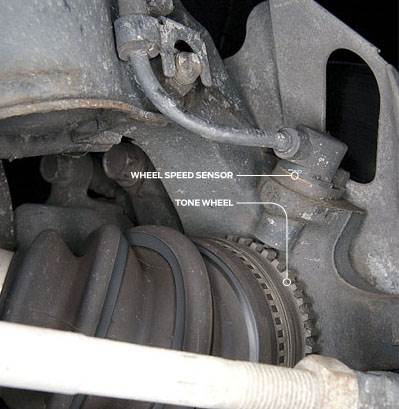The anti-lock braking system (ABS) on your vehicle is a specialized device helps shorten your stopping distance and make your stop safer, especially in a panic stop or in a slippery driving condition. It functions by helping prevent the wheel(s) form locking up on road surfaces that go against car stop, such as wet or icy road surfaces. Note: not all vehicles have anti-lock brakes. Anti-lock brakes are conventional on some vehicles and can be purchased as an option on others.
It is possible to diagnose and repair your ABS yourself.
Note: these are general instructions. Consult a repair manual written specifically for your truck, car, SUV or van for the exact procedure.
Your anti-lock brake system (ABS) helps maintain vehicular steering, directional stability, and optimum deceleration under difficult braking conditions on many types of road surfaces. The ABS monitors each wheel’s rotational speed and controls brake-line pressure to each wheel’s brakes during braking. Together these actions prevent the wheels from locking up.
The ABS has three main components: 1) an electronic control unit 2) a speed sensor on each wheel and 3) a hydraulic unit. The system works like this. The four wheel sensors the wheels routinely send electronic signals to the control unit. The control unit compares these signals to its internal program; it then make a determination about whether a wheel is about to lock up.
If the control unit senses that a wheel is about to lock up, it sends a signal to the hydraulic unit, telling the unit to reduce hydraulic pressure (or keep it at the present level). The braking unit at the wheel receives this electronic signal at the brake caliper. Electronically-operated solenoid valves control hydraulic pressure to the brakes.
If a problem develops in the system, an ABS warning light will illuminate on the dashboard. Visually inspecting the ABS can sometimes help locate the problem. Carefully inspect the wheel-sensor wiring harness. Pay special attention to the harness and the connections near each wheel, looking for signs of breaks or chafing. If the wires are incorrectly routed, it could cause these conditions. If the wheel-sensor wiring harness is damaged in any way, the sensor must be replaced.
Warning: Do not try to repair an ABS wiring harness. The ABS is very sensitive to even the slightest change in electrical charges. Repairing the harness could alter the electrical impulses flowing through the harness and cause the ABS to malfunction. If your ABS wiring harness is damaged in any way, replace it.
If your ABS warning light illuminates and stays on while your engine is operating, the ABS needs servicing. Even though special diagnostic tools are required to properly service the system, you can perform a few preliminary checks before taking it to an authorized repair facility.
Check the fuses.
Make sure the computer electrical connectors are secure.
Make sure there is a proper amount of brake fluid in the system by checking the fluid level in the reservoir.
Trace the wiring harness to each wheel and verify that the wiring is not damaged and that all connections are secure.
Check the electrical connections on the hydraulic control unit.

Diagnosing and Repair Instructions for the Anti-Lock Braking System
by
Tags:

Leave a Reply